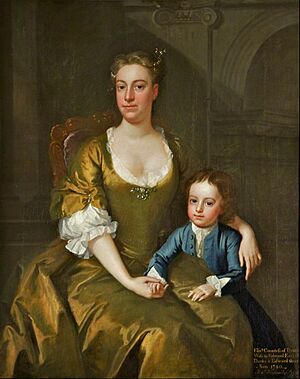Hamlet Winstanley facts for kids
Hamlet Winstanley (1698–1756) was an English artist. He was a painter, an engraver, and also helped people buy and sell art. He was mostly known for painting portraits and making copies of other artists' works.
His Life Story
Hamlet Winstanley was born in Warrington, England. His father was a tradesman. In 1707, Hamlet started learning from Samuel Shaw, a local teacher.
A man named John Finch, who was friends with a powerful earl, let Hamlet study and copy his art collection. Mr. Finch then helped Hamlet go to an art school in London. This school was called the Kneller Academy of Painting and Drawing. Hamlet studied there for three years and learned from a famous artist named Sir Godfrey Kneller.
In 1721, Winstanley returned to Warrington. He was asked to paint a portrait of Sir Edward Stanley. This painting was very successful. Because of it, he met James Stanley, 10th Earl of Derby. The Earl asked Hamlet to come and paint at his home, Knowsley Hall.
For the next two years, Hamlet painted landscapes and portraits for the Earl, including one of the Earl himself. From 1723 to 1725, the Earl paid for Hamlet to live and study in Rome, Italy. While there, Hamlet copied many paintings from Roman art collections for the Earl. He also helped the Earl buy paintings and sculptures.
After returning to London, Hamlet continued to work for the Earl. He would go to art auctions and buy art for him. Later in his life, Hamlet lived in Warrington. He even built a street there and named it Stanley Street, after his important art patrons. He passed away in Warrington on May 18, 1756.
His Artworks
Hamlet Winstanley mostly painted portraits and copied other famous paintings. He also made many sketches and drawings. The British Museum owns some of his drawings. The Yale Centre for British Art has a sketchbook with 81 of his drawings of body parts.
He made large copies of famous paintings like the Three Graces by Raphael and the Triumph of Bacchus by Annibale Caracci.
Etchings and Prints
Winstanley was also a skilled engraver. He made etchings, which are prints made from metal plates. He created a collection of etchings based on paintings owned by the Earl of Derby. These etchings showed works by old masters like Ribera, Rembrandt, Anthony van Dyck, and Rubens. This collection was put into a book called the Knowsley Gallery.
He painted portraits of many people, including members of the Stanley family. Some of his portraits were later turned into etchings or engravings by other artists. Sometimes, he would paint just the head of a person. Then, he would send it to another artist, Joseph Van Aken, who would paint the rest of the body and clothing.
Winstanley also made etchings of paintings by Sir James Thornhill that were in the dome of St Paul's Cathedral in London.




